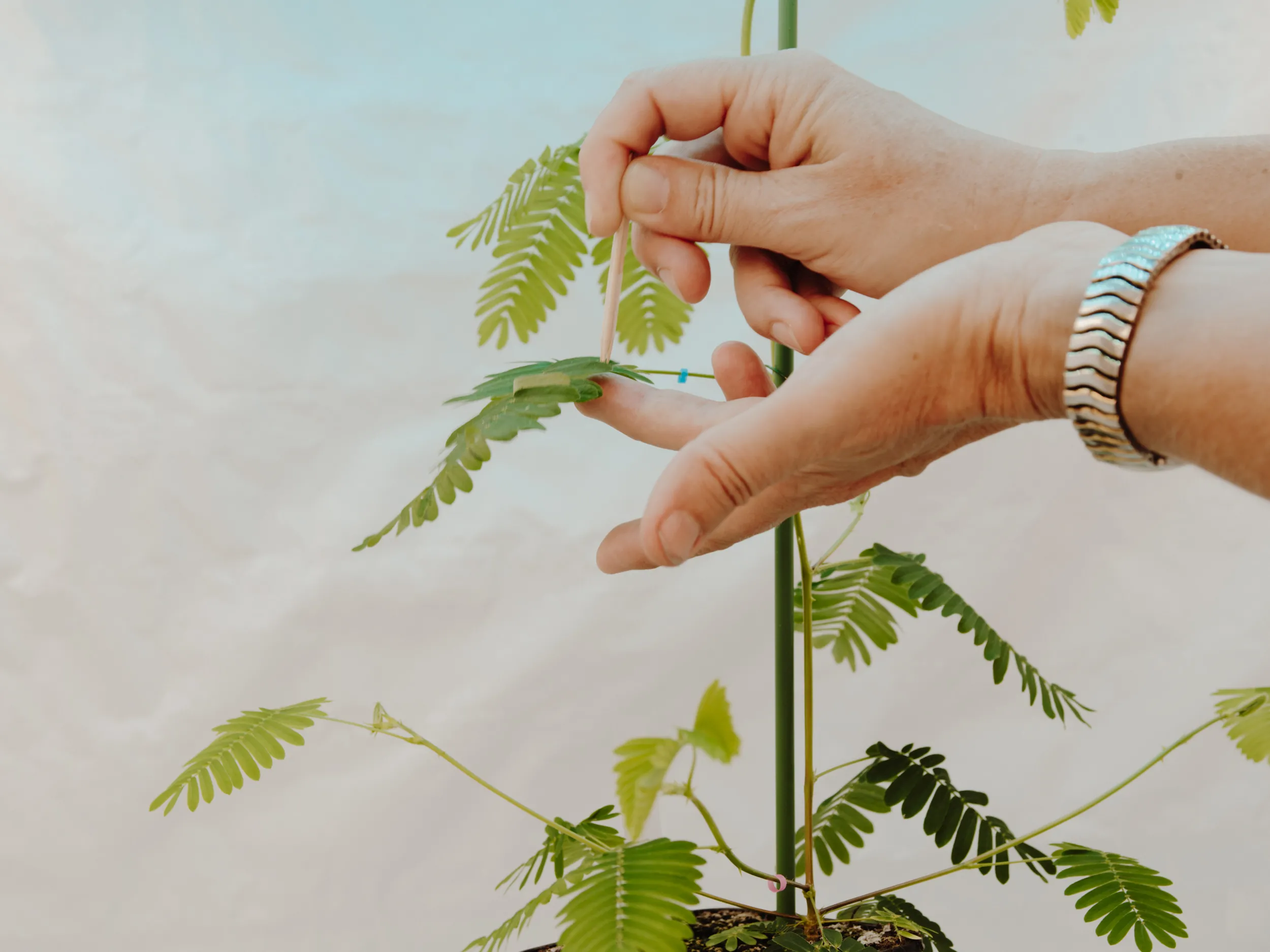
Ramon Haindl für VolkswagenStiftung
Like Pavlov’s Famous Dog?
Researchers in Tubingen are attempting to find out whether plants show comparable reflexes – and can therefore be regarded as capable of learning.
Mimosas live up to their proverbial image to an amazing degree. They are quick to show their displeasure. One tiny touch and the young plants in the Tubingen lab react immediately by folding in their delicate, feathery leaves.
For humans, such overt sensitivity went out of fashion with the Victorian era – even among ladies of the nobility. This isn’t true for at least one plant, though, which owing to its characteristic sensitivity is now enjoying a surprising research career.
"If you ask us, mimosa is the perfect test plant. We can see immediately when it is learning something," explains Katja Tielbörger, professor at the Institute of Evolution and Ecology at the University of Tübingen.

Mimosa in the greenhouse at the Institute for Evolution and Ecology of the University of Tübingen.

Katja Tielbörger (right) and Michal Gruntmann "tease" Venus flytraps.
Tielbörger and her colleague Michal Gruntman are working on an unusual research project. They want to answer the fundamental question: Are plants capable of learning? So far, biologists were of one accord: it takes a brain to have the capacity to learn – so you can teach animals something. But not plants. And that’s that.
The Tubingen botanists are now fundamentally challenging this conventional wisdom with their project titled "Pavlovian Plants". Although viewed with suspicion by experts in the field, the Volkswagen Foundation decided to support the project – precisely because it is an extraordinary and radically new research idea.
From the Foundation’s point of view, the project fits ideally into its "Experiment!" funding initiative, which aims to encourage innovative scientific exploration of courageous research ideas.
"In our perception, plants are simply just there and are nice to look at. We have the preconceived notion that they're rather uninteresting contemporaries," says Tielbörger. "But precisely because they can't run away from predators, plants must have developed some kind of survival strategy." Tobacco plants are an example: they defend themselves against predators with toxic antibodies.

Mimosa is an ideal research object for the two scientists.
Our inquiry is indeed a bit crazy
Even the mimosa is by no means just a self-pitying "wallflower". Although when touched it quickly folds in its leaves because it wants to protect itself, if it is touched too often it seems to draw the right conclusion – so to speak – and ceases to react. "Apparently, it is able to ‘learn’ that it is being deluded into ‘thinking’ something," adds Michal Gruntman.
This behavior makes mimosa ideal for the project, whose title "Pavlovian Plants" alludes to the famous experiment by physiologist Ivan Pavlov. He had conditioned dogs to believe that food – as a real stimulus – is always preceded by the sound of a bell. Soon the dogs began to salivate on hearing the bell ring, i.e. they responded to an unreal stimulus.
"Plants don’t have a brain or a nervous system like a dog, but they can learn in other ways. They are able to perceive their environment and react to it accordingly," stresses Tielbörger.
In almost two years of research, the botanists have tested three very different plant species for their ability to connect a fake stimulus to a real stimulus; namely, mimosa, Venus flytraps and thale cress – the classic model organisms in plant biology. When subjected to blue light as a fake stimulus, the flesh-eating Venus flytrap reacts in expectation of a hearty meal. Mimosa was flooded with bright overhead light prior to attacks with a toothpick. And in the case of thale cress, the light stimulus was combined with a gravitational stimulus – by tilting the plant pots.

The carnivorous Venus flytrap is fed.

Mimosas are sensitive, but also quick to learn.
However, thale cress and Venus flytrap proved to be rather unsuitable. "The Venus flytrap takes a good week to digest its favorite foods of chicken protein or flies. After such a long time, it forgets the connection between blue light and food," says Gruntman laconically.
The mimosa, on the other hand, did actually learn that blue light was always followed by an attack with the ominous stick – in hasty foresight, after just three "trainings" it folded its leaves as soon as the light was turned on. This was documented with a camera that took a photo every second. But after three days it was over – the mimosas ceased to react altogether.
"Had it really come to the conclusion that it wasn’t about to be eaten after all? Unfortunately, we don't know," explains Gruntman. Another experiment was more promising, though. "We left the mimosas in the dark for a very long period and then switched on the light for just ten minutes at a time. So the plant had to make good use of the short period of light in order to carry out photosynthesis." The mimosa quickly learned to change its usual behavior of folding its leaves in the dark – this enabled it to stretch up more quickly when exposed to light and make maximum use of the artificial sun. "These experiments are promising, but we need more repeats in order to be able to document the relationship more significantly," says Tielbörger.
Following this initial exploration, the researchers can’t wait to continue their project and their mission to free the plants of this world from their image as mere 'green stuff'. "Our inquiry is indeed a bit crazy," laughs Tielbörger. "But it's great to be allowed to break fundamentally new ground. Why do plants react like this? We don't really know anything at all about it." Now a start has been made that might change this.

After a short training session, mimosas already fold their leaves when light falls on them.


